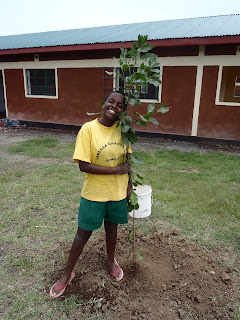We got off the Matatu (mini-van bus) at the end of the line and walked down the puddle filled road to the shamba. We entered through the corrugated metal gate into a relatively green area that might be the biggest open space in Mgongo. Sammy and Eric (the farmers) meet us and immediately we take another tour around and get to discussing some options. The house on the compound is falling apart, with half of the roof still intact and the other half completely fallen into the house itself. There is a roofed area where they do tie dying of dresses to sell at market that has a roof that is for the most part intact.
The almost dry borehole (the well) and the underground rain water tank are located directly beside the septic tank, which is definite cause for concern as most of the community comes here to get their drinking water. Both the well and the tank are covered by cracked cement that the goats walk over and could be contaminated really easily.
The growing area is dry and not nearly as productive as it once was, we were told. There is one area where the grey water from the neighbours seeps under the cement wall which is watering the banana trees nicely, making for a little green oasis in the corner of the property. There are papaya trees dispersed throughout the production field in an attempt to offer some shade to plants growing below, which is a step in the right direction. There is a small forested patch that Sammy has left as he understands the importance of shade. This area is beside the chicken coop which is great as the chickens go in and forage frequently. As we're chatting seven goats come running along butting each other out of the way to get a drink of water.
Sammy and Eric are set. They have small animals, land to use, trees growing and are keen to produce more food in any way possible. We told them it may be more experimental at this point and their response was that so little grows now that they are willing to try anything.
We offered the advice we could. One suggestion was to stop tilling their land. Currently they weed all of the dead plants out and mix up the soil. This is fairly common procedure, but in doing this they're drying out the soil and killing the micro-organisms that keep the soil healthy we explained. They agreed to try direct planting into the soil without tilling. We also pushed the idea of mulching everything. It's crucial that they not have any soil bare in this climate. When it's exposed to the elements you run into erosion and evaporation, which they already knew, but needed reminding. When we mentioned using a green mulch like groundnuts and squash they were happier to hear that they can do this and produce food at the same time.
 |
| A borrowed picture of the garden bags. |
These were some of the ideas we presented them, mainly Sammy as he's the main farming guy. We also talked about swales, intercropping and not using straight lines. I'll keep in touch with Sammy and Eric and hopefully we can get them to a permaculture course in the future and use their plot as a demonstration to the community at Mgongo.



































